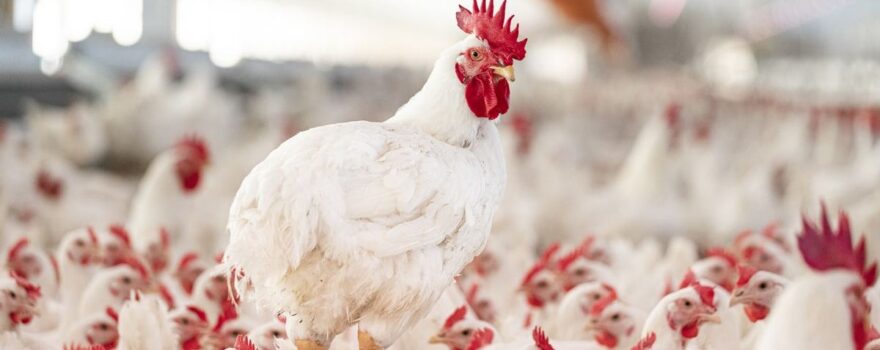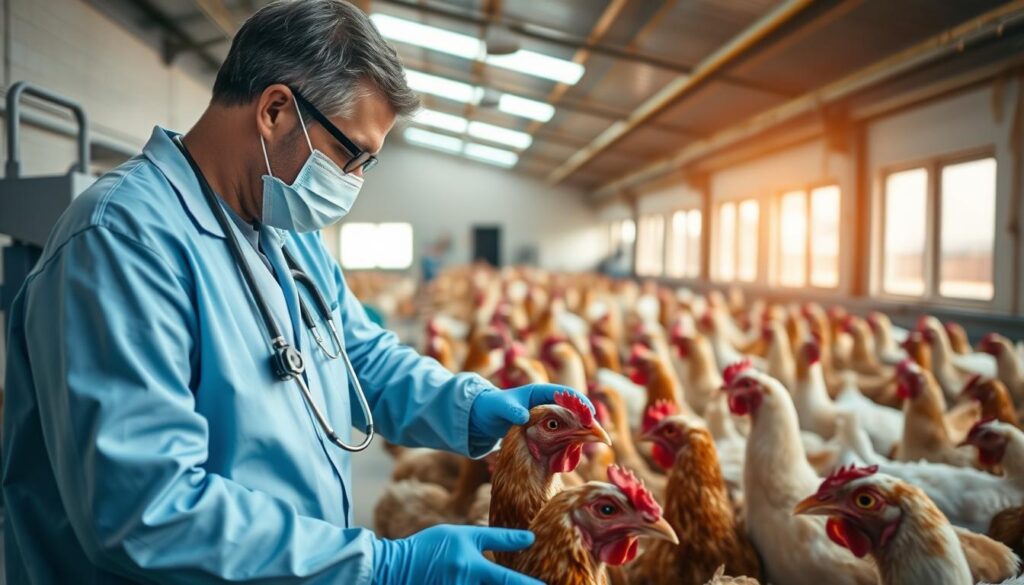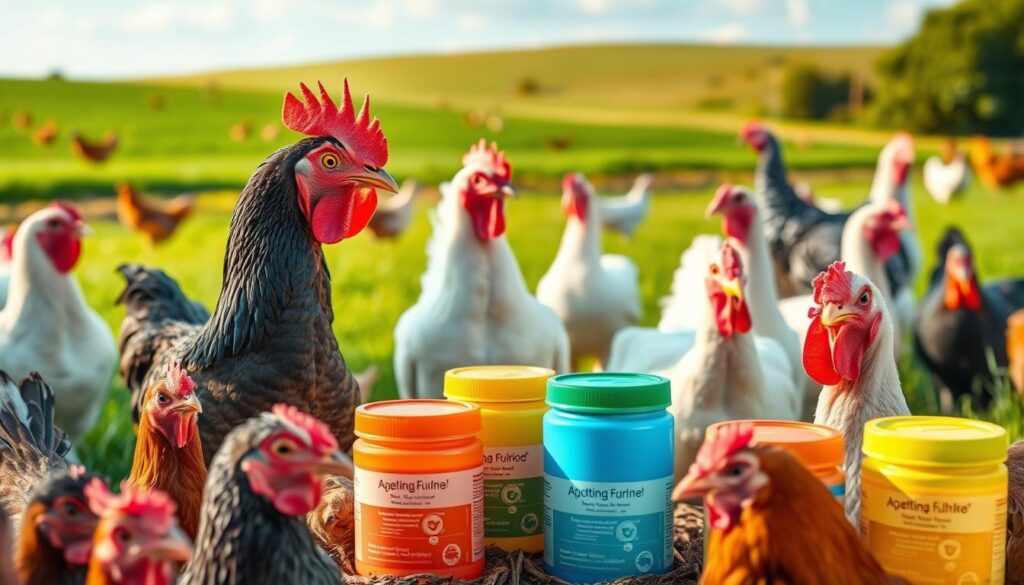
The United States has a detailed plan to control antibiotic use in poultry farming. The Food and Drug Administration (FDA) and the United States Department of Agriculture (USDA) work together. They create rules to use important antibiotics wisely in animals, like poultry. This helps manage diseases without making antibiotics less effective.
One key rule is to stop using antibiotics just to make animals grow faster. The FDA has rules, called Guidance #209 and #213, to help with this. They say antibiotics can only be used when a vet says it’s okay for a specific disease. This change helps keep antibiotics working well for people.
The Veterinary Feed Directive (VFD) and the Animal Drug Availability Act add more rules. They make sure antibiotics are used only when a vet says it’s okay. This way, antibiotics are not used too much or in the wrong way.
Key Takeaways
- The United States has a comprehensive regulatory framework governing antibiotic use in poultry farming, involving the FDA and USDA.
- Guidance #209 and #213 have phased out the use of antibiotics for growth promotion, limiting their use to addressing specific disease conditions under veterinary supervision.
- The Veterinary Feed Directive and Animal Drug Availability Act establish requirements for veterinary oversight and supervision of antimicrobial use in food-producing animals.
- The regulatory environment aims to balance the need for effective disease management with the imperative to mitigate the growing threat of antimicrobial resistance.
- Responsible and targeted use of antibiotics in poultry farming is crucial to preserving the effectiveness of these critical medical resources.
Introduction to Antibiotic Use in Poultry Farming
Antibiotics have been key to the poultry industry’s success. They help treat diseases and boost growth in flocks. But, their overuse has led to antibiotic resistance, threatening public health and food safety.
Overview of Antibiotic Use in Poultry Production
The poultry industry uses a lot of antibiotics, with over 90 billion tons of chicken meat produced yearly. More than 60% of all antibiotics produced are used in livestock production, including poultry. This has caused antibiotic-resistant bacteria to spread, posing risks to humans through food and the environment.
Importance of Regulatory Framework for Antibiotic Use
A strong regulatory framework is vital for the judicious use of antibiotics in poultry farming. It balances animal health with public health and environmental protection. The FDA and USDA have rules to ensure antibiotics are used wisely. This helps safeguard food safety, environmental sustainability, and public health by reducing antibiotic-resistant pathogens.
| Country | Antibiotic Resistance Findings |
|---|---|
| Africa | Livestock-associated Staphylococci showed susceptibility to amoxicillin/clavulanic acid, amikacin, ciprofloxacin, gentamicin, and cephalexin. |
| Ghana | Pseudomonas aeruginosa isolated from poultry litter showed susceptibility to levofloxacin (20–100%) and intermediate susceptibility to aztreonam (nearly 75%). |
| Nigeria | P. aeruginosa isolates were highly resistant to β-lactams, tetracycline, tobramycin, nitrofurantoin, and sulfamethoxazole-trimethoprim. |
| India | 1.6% of staphylococcal isolates contained the mecA resistant gene. |
| Pakistan | A study investigated [specific aspect or parameter] regarding antibiotic resistance in poultry. |
These findings show the need for a strong regulatory framework. It’s crucial for tackling antibiotic resistance in poultry production. This will help protect public health, food safety, and the environment.
United States Regulatory Environment
The rules for using antibiotics in poultry farming in the U.S. come from the FDA (Food and Drug Administration) and the USDA (United States Department of Agriculture). These groups help set policies to fight antibiotic resistance and promote antimicrobial stewardship.
FDA Guidance #209 and #213: Phasing Out Growth Promotion Indications
The FDA has made big moves to limit the use of medically important antimicrobials in animals. Guidance #209 and Guidance #213 say these antibiotics should only be used for animal health, with a vet’s help. These rules help stop antibiotics from being used just to make animals grow faster.
The USDA helps enforce these FDA policies in the poultry industry. Working together, the FDA and USDA aim to make sure antibiotics are used wisely in poultry farming.
“The updated guideline strongly encourages the use of third-party certification to substantiate claims related to animal-raising practices or environmental impacts.”
Understanding the Regulatory Environment for Antibiotic Use in Poultry Farming
The rules for antibiotics in poultry farming come from two main sources: the Veterinary Feed Directive (VFD) and the Animal Drug Availability Act. These laws aim to make sure antibiotics are used wisely. They also increase Veterinary Oversight in raising poultry.
Veterinary Feed Directive (VFD) and Animal Drug Availability Act
The VFD makes sure vets are in charge of antibiotics given through animal feed. This ensures these important drugs are used right. The Animal Drug Availability Act also sets rules for animal drugs, including antibiotics, in the U.S.
Medically Important Antimicrobials and Oversight Requirements
The rules focus a lot on Medically Important Antimicrobials in poultry farming. These antibiotics are key for human health. Their use in animals is closely watched and vet-approved. Vets make sure antibiotics are used carefully and as needed.
The rules for Veterinary Feed Medications and VFD Regulations aim to fight Antimicrobial Resistance. They help keep both animal and human health safe in the poultry industry. This is done through careful Veterinary Oversight and Antimicrobial Stewardship.

Antimicrobial Resistance and Public Health Concerns
The use of antibiotics in poultry farming has led to Antimicrobial Resistance. This is a big threat to public health. Resistant bacteria can spread to humans through food or the environment. This makes foodborne illnesses harder to treat and weakens medical treatments.
The world faces a big problem with antimicrobial resistance. It’s a major health issue that needs a One Health solution. This approach sees health as connected between humans, animals, and the environment. It shows the need for teams working together to fight resistant pathogens.
Impact of Antimicrobial Resistance on Human Health
There’s been a big rise in antimicrobial resistance in animals, especially in poorer countries. The poultry industry uses a lot of antibiotics, as reports show. This makes it a big public health concern as resistant bacteria can spread to people.
One Health Approach to Antimicrobial Resistance
The One Health way to tackle antimicrobial resistance is key. It looks at environmental health and the link between animals and humans. By working together, we can find better ways to stop resistant pathogens and protect public health.
“It is estimated that in 2050, the mortality rate caused by resistant bacterial infections will exceed the mortality rate caused by cancer if the rate of development of multidrug resistant (MDR) bacteria continues to increase.”
Judicious Use of Antimicrobials in Poultry
To use antimicrobials wisely in poultry farming, rules and guidelines have been set. These rules come from groups like the American Veterinary Medical Association (AVMA) and the American Association of Avian Pathologists (AAAP). They stress the need for Antibiotic Stewardship, Disease Prevention, and precise Diagnostic Testing. These are key for Therapeutic Use and Antimicrobial Guidelines.
Principles and Guidelines for Therapeutic Antimicrobial Use
Veterinarians are vital in following these rules and making smart choices about Antibiotic Use in poultry. Important guidelines include:
- Having a valid Veterinary Oversight through a vet-client-patient relationship
- Using Diagnostic Testing to confirm infections before giving antimicrobials
- Picking the right antimicrobial based on its effectiveness and human impact
- Using the correct amount, time, and withdrawal period to lower Antimicrobial Resistance risk
- Keeping detailed records of antimicrobial use and results for future checks
Disease Prevention and Diagnosis in Poultry
The rules for Antibiotic Use in poultry farming focus on Disease Prevention and accurate diagnosis first. Ways to prevent disease include improving the poultry environment, keeping strict Biosecurity measures, and using Vaccination programs. When antibiotics are needed, vets should use diagnostic tests and farm history to pick the best antimicrobial and lower resistance risk.
“Antimicrobial stewardship refers to actions by veterinarians to preserve antimicrobial drug effectiveness and availability.”
By following these rules and guidelines, poultry producers can use antimicrobials wisely. This helps in managing Poultry Health and tackles the issue of Antimicrobial Resistance.
Approved Antimicrobials for Poultry
In the United States, certain FDA Approved Antibiotics are okay for use in poultry. These Approved Antimicrobials fall into different Antimicrobial Classes. They are safe and work well for Poultry Medicine. Veterinarians must follow the label and rules for using these antimicrobials. This includes limits on how much to use, how to give it, and when to stop using it.
Classes of Antimicrobials Approved by FDA
The FDA Approved Antibiotics for poultry include:
- Penicillins
- Tetracyclines
- Macrolides
- Sulfonamides
- Aminoglycosides
- Cephalosporins
- Fluoroquinolones
These Approved Antimicrobials are used in poultry for treating diseases, preventing them, and sometimes to help them grow. Veterinarians are key in making sure these antimicrobials are used right. This helps keep poultry healthy and reduces the chance of antimicrobial resistance.
“Responsible use of antibiotics in poultry is essential for protecting both animal and human health.”

The rules for using Approved Antimicrobials in Poultry Medicine aim to manage diseases well. But they also protect public health. Veterinarians and poultry farmers must stick to FDA guidelines and rules. This ensures the FDA Approved Antibiotics are used wisely and sustainably.
Alternatives and Future Directions
The poultry industry is looking into sustainable farming practices and alternative antimicrobial therapies. These efforts aim to cut down on the use of antimicrobials while keeping animals healthy and safe.
Exploring Sustainable Farming Practices
Rules are pushing for biosecurity measures, better animal husbandry, and non-antibiotic feed additives and immunotherapies. These methods help reduce the need for important antimicrobials. They also support environmental sustainability and animal welfare.
Developing New Antimicrobial Therapies
Rules are also encouraging the creation of novel antimicrobial compounds. Researchers and companies are working hard to find and market new treatments. These treatments aim to help poultry production while fighting antimicrobial resistance.
The rules help guide the introduction of new antimicrobial therapies. They ensure these treatments are used responsibly. This aligns with One Health and environmental sustainability.
| Alternative Approach | Description | Potential Benefits |
|---|---|---|
| Biosecurity Measures | Implementation of strict hygiene protocols, limiting pathogen exposure, and controlling disease transmission. | Reduced need for antimicrobial interventions, improved animal welfare, and enhanced environmental sustainability. |
| Improved Animal Husbandry | Optimizing animal housing, nutrition, and overall management practices to support animal health and productivity. | Improved immune function, reduced susceptibility to infections, and minimized reliance on antimicrobials. |
| Non-Antibiotic Feed Additives | Utilization of probiotics, prebiotics, essential oils, and other natural compounds to support gut health and immune function. | Promotion of beneficial gut microbiome, enhanced disease resistance, and reduced need for antimicrobial interventions. |
| Immunotherapies | Development and application of vaccines, antibodies, and other immunomodulatory agents to prevent and control infectious diseases. | Strengthened immune responses, reduced susceptibility to pathogens, and decreased reliance on antimicrobials. |
“Sustainable poultry farming practices that minimize the use of medically important antimicrobials are essential for safeguarding public health and the environment.”
Regional Regulatory Frameworks
The rules for using antibiotics in poultry farming are mainly set by the FDA and USDA in the U.S. But, other areas have their own rules too. In Latin America, the Mercosur trade group has made rules for using antimicrobials in animals, including chickens. These rules help countries work together and use antibiotics wisely.
Mercosur Regulations and Guidelines
The Mercosur area, which includes Argentina, Brazil, Paraguay, and Uruguay, is taking steps to control antibiotic use in chicken farms. Brazil, for example, made a rule in 2018 about using antimicrobials. Uruguay also made a rule in 2011 about how to make animal feed safely.
Regulatory Environments in Latin American Countries
Each Latin American country has its own rules for antibiotics in chicken farms. Colombia made a rule in 1996 about checking animal products. Argentina made a rule in 2002 about making veterinary products safely. These rules help fight antibiotic resistance and use antibiotics wisely.
These efforts show that the problem of antibiotic use is worldwide. It’s important for countries to work together to solve it.
| Country | Regulatory Measure | Year |
|---|---|---|
| Brazil | Instruction Normative No. 54 – Technical Regulation for the Registration of Antimicrobial Performance Enhancers and Anticoccidial Feed Additives | 2018 |
| Colombia | Resolution 1056 – Provisions on the technical control of animal inputs | 1996 |
| Uruguay | Resolution No. 48 – Technical Standard of Good Manufacturing Practices | 2011 |
| Argentina | Resolution 482 – Good Manufacturing Practices for Veterinary Products | 2002 |
| Chile | Resolution 5.025 – Quality Assurance Program in factories or manufacturers of animal feed and supplements | 2009 |
Industry Compliance and Monitoring
To make sure antibiotics work well in poultry farming, we need strong rules and checks. This means setting up Antimicrobial Resistance Surveillance programs. These programs track resistant bacteria in poultry and food. The data helps make better policies and decisions.
The U.S. has set Reporting Standards and Data Collection rules. Poultry farms and vets must report on antibiotic use and resistance. This info helps shape policies, track trends, and check if rules are followed. Data Transparency and Regulatory Oversight are key for good rules and checks.
Surveillance Programs for Antimicrobial Resistance
The U.S. has strong Antimicrobial Resistance Surveillance programs. They track resistant bacteria in poultry and food. Data comes from farms, processing plants, and stores, giving a full picture of resistance.
Reporting Requirements and Data Collection
To keep rules in place and enforce them, the U.S. has strict Reporting Requirements. Poultry farms and vets must report antibiotic use and resistance. This data helps make policies, track trends, and check rule-following.
“Transparent data reporting and collection are essential for the effective implementation and evaluation of the regulatory environment.
The rules for using antibiotics in poultry farming in the U.S. are strict and always changing. They aim to improve Regulatory Oversight, Antimicrobial Stewardship, and Public Health Protection. These rules make sure vets are in charge, limit antibiotics for growth, and push for Sustainable Poultry Farming.
As antibiotics resistance grows, these rules must also change. They need to work together with the industry, lawmakers, and health experts. This way, they can keep poultry, people, and the planet safe.
The strict rules in the U.S. show how important it is to balance farming and health. As the industry deals with these tough issues, the rules will guide the use of antibiotics. They aim to protect both animals and humans.